

Compact Muon Solenoid
LHC, CERN
| CMS-PAS-EXO-17-015 | ||
| Search for dark matter in final states with a leptoquark and missing transverse momentum in proton-proton collisions at 13 TeV | ||
| CMS Collaboration | ||
| July 2018 | ||
| Abstract: A search for dark matter is presented in proton-proton collisions at a center-of-mass energy of $\sqrt{s}= $ 13 TeV using events with at least one high transverse momentum ($p_{\mathrm{T}}$) muon, at least one high $p_{\mathrm{T}}$ jet, and large missing transverse momentum. The search is performed in the context of the so-called coannihilation codex, a new paradigm that introduces novel scenarios for dark matter production. The data were collected with the CMS detector at the CERN LHC in 2016 and 2017, and correspond to an integrated luminosity of 77.4 fb$^{-1}$. In the examined scenario, a pair of scalar leptoquarks is assumed to be produced. One leptoquark decays to a muon and a jet while the other decays to dark matter and soft standard model particles. The dark matter signature is given by a peak at the leptoquark mass in the invariant mass distribution of the highest $p_{\mathrm{T}}$ muon and jet. The data are observed to agree with the predictions from the standard model. Leptoquarks with masses up to 1160 GeV are excluded. | ||
|
Links:
CDS record (PDF) ;
inSPIRE record ;
CADI line (restricted) ;
These preliminary results are superseded in this paper, PLB 795 (2019) 76. The superseded preliminary plots can be found here. |
||
| Figures | |
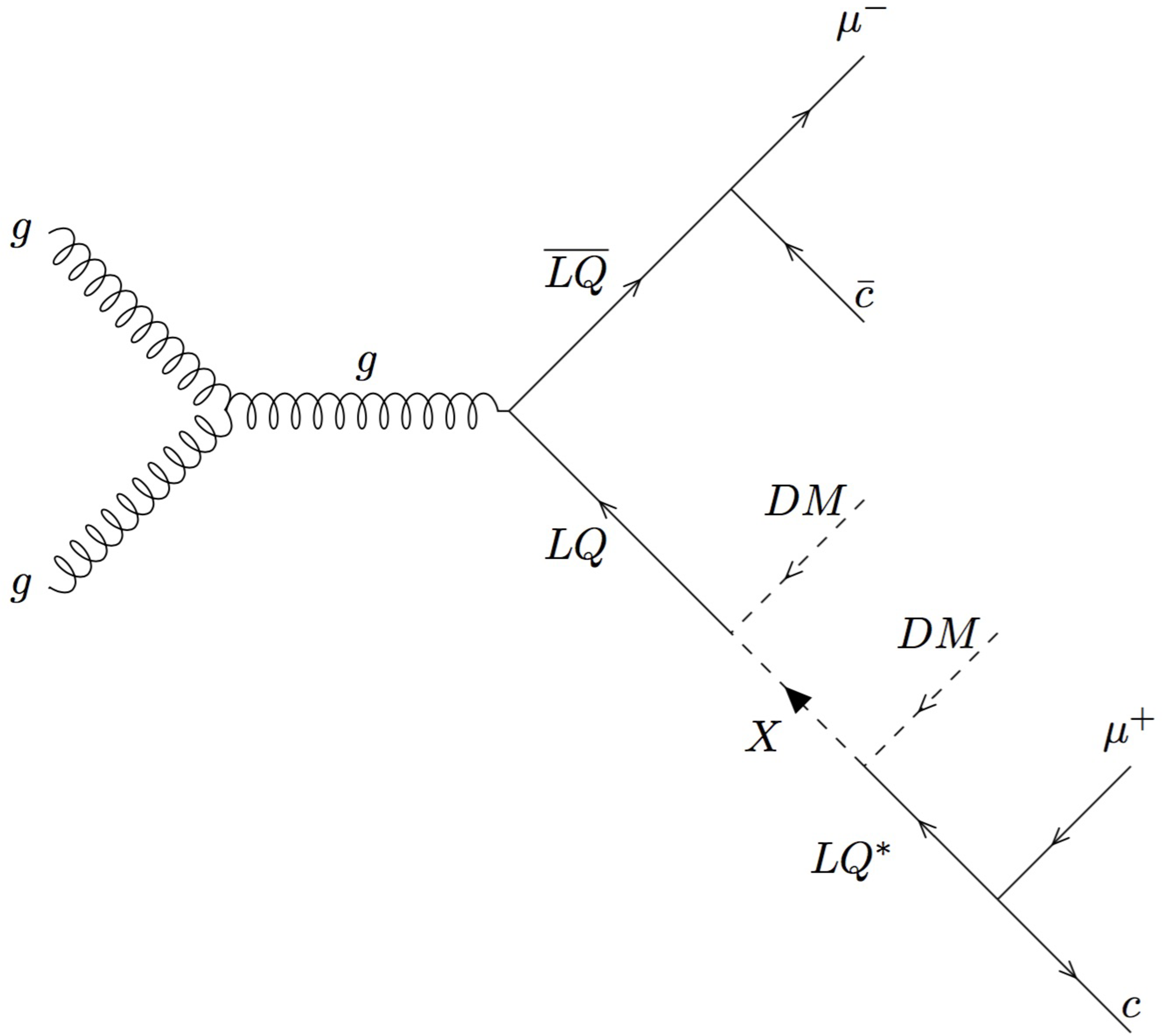
png pdf |
Figure 1:
Example Feynman diagram for the signal process considered in this study, where ${\mathrm {g}}$ is a gluon, LQ a leptoquark, DM a dark matter particle, and X a new Dirac fermion. The superscript "*'' indicates an off-shell particle. |
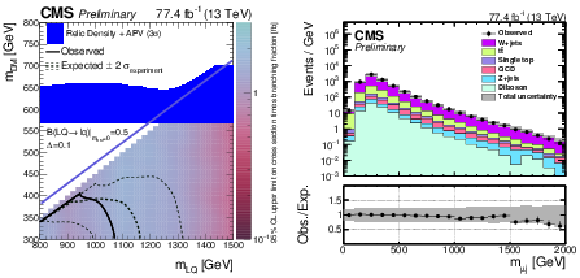
png pdf |
Figure 2:
The ${{m_{{\mu} \mathrm {j}}}}$ distributions in data and simulation for the (left) ${{\mathrm {t}\overline {\mathrm {t}}}}$- and (right) W+jets-enriched control samples for the combined 2016 and 2017 data sets. The respective data-to-simulation normalization scale factors have been applied to the simulated distributions. The lower panels show the ratio of the observed to the simulated results. The vertical error bars on the observed points indicate the statistical uncertainties. The gray band shows the total uncertainties, including both statistical and systematic terms. |
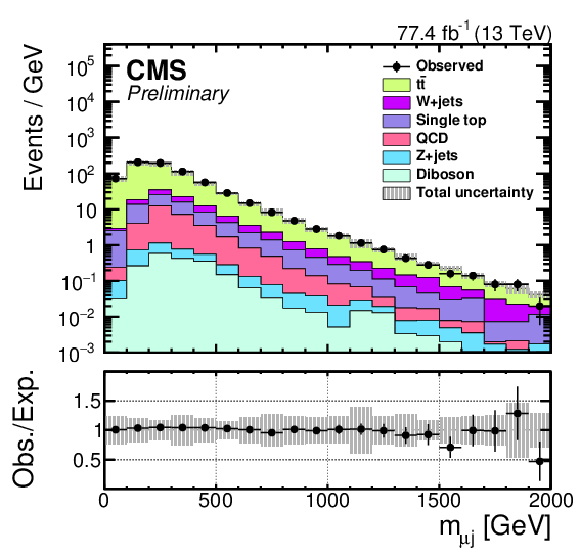
png pdf |
Figure 2-a:
The ${{m_{{\mu} \mathrm {j}}}}$ distributions in data and simulation for the (left) ${{\mathrm {t}\overline {\mathrm {t}}}}$- and (right) W+jets-enriched control samples for the combined 2016 and 2017 data sets. The respective data-to-simulation normalization scale factors have been applied to the simulated distributions. The lower panels show the ratio of the observed to the simulated results. The vertical error bars on the observed points indicate the statistical uncertainties. The gray band shows the total uncertainties, including both statistical and systematic terms. |
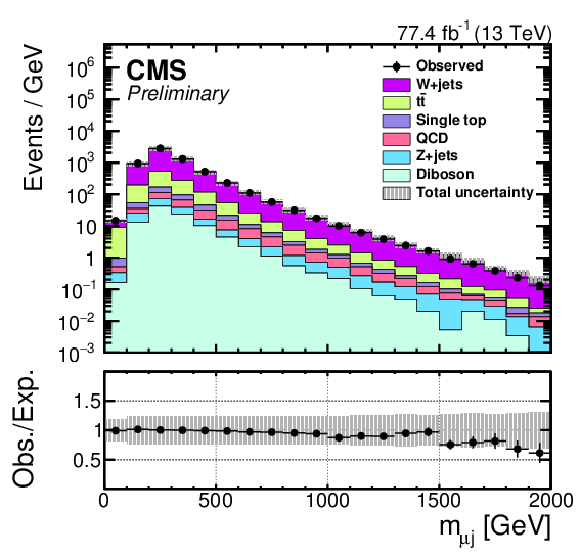
png pdf |
Figure 2-b:
The ${{m_{{\mu} \mathrm {j}}}}$ distributions in data and simulation for the (left) ${{\mathrm {t}\overline {\mathrm {t}}}}$- and (right) W+jets-enriched control samples for the combined 2016 and 2017 data sets. The respective data-to-simulation normalization scale factors have been applied to the simulated distributions. The lower panels show the ratio of the observed to the simulated results. The vertical error bars on the observed points indicate the statistical uncertainties. The gray band shows the total uncertainties, including both statistical and systematic terms. |
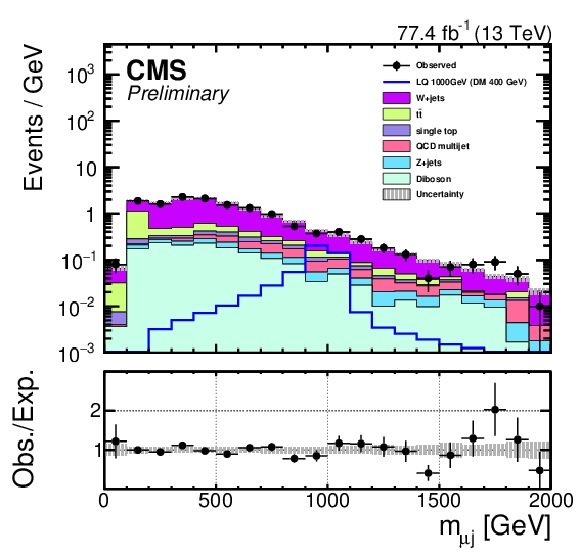
png pdf |
Figure 3:
The observed distribution of ${{m_{{\mu} \mathrm {j}}}}$ in comparison to the postfit SM background predictions for the combined 2016 and 2017 data sets. "Postfit'' means that the constraints from the maximum likelihood fit are incorporated. The unstacked prediction for a signal model with $ {{m_{\mathrm {LQ}}}} = $ 1000 GeV and $ {m_{\mathrm {DM}}} = $ 400 GeV is also shown. The ratio of the observed results to the total SM prediction is shown in the lower panel. The vertical error bars on the observed points indicate the statistical uncertainties. The gray band shows the total uncertainties, including both statistical and systematic terms. |
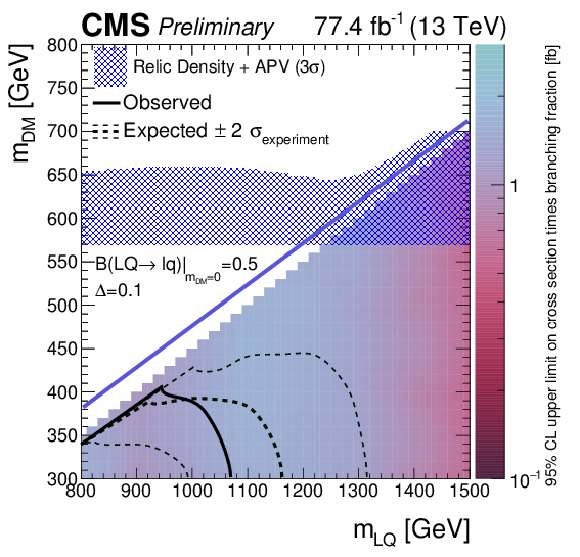
png pdf |
Figure 4:
Observed upper limits at 95% CL on the product of cross section and branching fraction, for the signal model of Fig. xxxxx. The hatched (blue) band represents the region where the dark matter relic density requirement can be satisfied within 3 standard deviations ($\sigma $), including the APV bounds. The solid and dashed (black) curves show the observed and expected 95% CL exclusion curves. |
| Tables | |
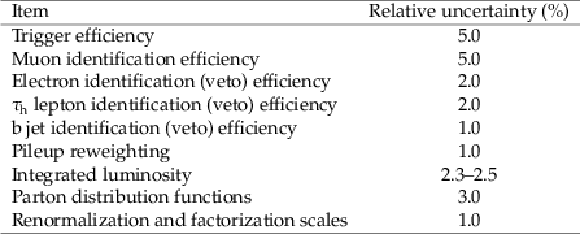
png pdf |
Table 1:
Systematic uncertainties in the yield of signal events assuming leptoquark and dark matter masses of 1000 and 400 GeV, respectively. |
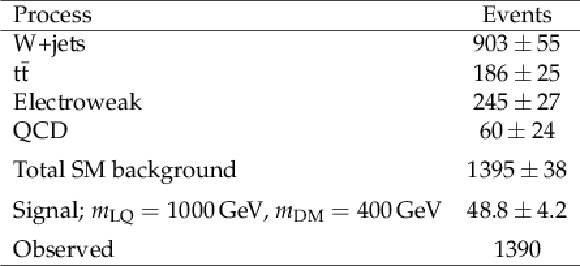
png pdf |
Table 2:
Observed number of events and postfit SM background predictions for the combined 2016 and 2017 data sets. "Electroweak" refers to the sum of expected events from the single top quark, Z boson, and diboson background processes. The prediction for a signal model with $ {{m_{\mathrm {LQ}}}} = $ 1000 GeV and $ {m_{\mathrm {DM}}} = $ 400 GeV is also shown. The uncertainties represent the statistical and systematic terms added in quadrature. |
| Summary |
|
A search is performed for dark matter in events containing a muon, a jet, and significant missing transverse momentum. The study is performed using proton-proton collision data at $\sqrt{s} = $ 13 TeV recorded with the CMS detector at the LHC. The data correspond to an integrated luminosity of 77.4 fb$^{-1}$. We assume the production of dark matter through the pair production of a leptoquark pair, in which one leptoquark decays to a muon and a jet and the other to DM and soft standard model particles. The study is performed by searching for a peak in the leptoquark candidate invariant mass $ m_{\mu\mathrm{j}} $ distribution formed from the highest ${p_{\mathrm{T}}}$ muon and jet in an event, after requiring significant missing transverse momentum as is expected from the presence of DM. The search for a peak in $ m_{\mu\mathrm{j}} $ provides a novel means to search for DM at the LHC. The data are observed to agree with the standard model predictions within the uncertainties. Upper limits on the product of cross section and branching fraction, divided by the theoretical cross section, are determined at 95% confidence level as a function of the leptoquark and dark matter particle masses. Leptoquarks with masses up to 1160 GeV are excluded for dark matter mass ${m_{\mathrm{DM}}} \approx $ 300 GeV, and up to 1000 GeV for ${m_{\mathrm{DM}}} \approx $ 425 GeV. |
| References | ||||
| 1 | G. Bertone, D. Hooper, and J. Silk | Particle dark matter: Evidence, candidates and constraints | PR 405 (2005) 279 | hep-ph/0404175 |
| 2 | J. L. Feng | Dark matter candidates from particle physics and methods of detection | Ann. Rev. Astron. Astrophys. 48 (2010) 495 | 1003.0904 |
| 3 | T. A. Porter, R. P. Johnson, and P. W. Graham | Dark matter searches with astroparticle data | Ann. Rev. Astron. Astrophys. 49 (2011) 155 | 1104.2836 |
| 4 | Particle Data Group, C. Patrignani et al. | Review of particle physics | CPC 40 (2016) 100001 | |
| 5 | Planck Collaboration | Planck 2015 results. XIII. Cosmological parameters | Astron. Astrophys. 594 (2016) A13 | 1502.01589 |
| 6 | ATLAS Collaboration | Search for dark matter in events with a hadronically decaying W or Z boson and missing transverse momentum in $ pp $ collisions at $ \sqrt{s} = $ 8 TeV with the ATLAS detector | PRL 112 (2014) 041802 | 1309.4017 |
| 7 | CMS Collaboration | Search for dark matter, extra dimensions, and unparticles in monojet events in proton-proton collisions at $ \sqrt{s} = $ 8 TeV | EPJC 75 (2015) 235 | CMS-EXO-12-048 1408.3583 |
| 8 | ATLAS Collaboration | Search for new phenomena in final states with an energetic jet and large missing transverse momentum in pp collisions at $ \sqrt{s}= $ 8 TeV with the ATLAS detector | EPJC 75 (2015) 299 | 1502.01518 |
| 9 | CMS Collaboration | Search for dark matter in proton-proton collisions at 8 TeV with missing transverse momentum and vector boson tagged jets | JHEP 12 (2016) 083 | CMS-EXO-12-055 1607.05764 |
| 10 | ATLAS Collaboration | Search for new phenomena in final states with an energetic jet and large missing transverse momentum in $ pp $ collisions at $ \sqrt{s}= $ 13 TeV using the ATLAS detector | PRD 94 (2016) 032005 | 1604.07773 |
| 11 | ATLAS Collaboration | Search for dark matter produced in association with a hadronically decaying vector boson in $ pp $ collisions at $ \sqrt{s} = $ 13 TeV with the ATLAS detector | PLB 763 (2016) 251 | 1608.02372 |
| 12 | M. J. Baker et al. | The Coannihilation Codex | JHEP 12 (2015) 120 | 1510.03434 |
| 13 | CMS Collaboration | Search for pair production of second generation leptoquarks at $ \sqrt{s}= $ 13 TeV | To be submitted to \it PRD [information to be updated following submission] | XXX.XXXXX |
| 14 | CMS Collaboration | The CMS experiment at the CERN LHC | JINST 3 (2008) S08004 | CMS-00-001 |
| 15 | CMS Collaboration | The CMS trigger system | JINST 12 (2017) P01020 | CMS-TRG-12-001 1609.02366 |
| 16 | CMS Collaboration | Particle-flow reconstruction and global event description with the CMS detector | JINST 12 (2017) P10003 | CMS-PRF-14-001 1706.04965 |
| 17 | CMS Collaboration | Performance of CMS muon reconstruction in pp collision events at $ \sqrt{s} = $ 7 TeV | JINST 7 (2012) P10002 | CMS-MUO-10-004 1206.4071 |
| 18 | CMS Collaboration | Performance of electron reconstruction and selection with the CMS detector in proton-proton collisions at $ \sqrt{s} = $ 8 TeV | JINST 10 (2015) P06005 | CMS-EGM-13-001 1502.02701 |
| 19 | CMS Collaboration | Performance of reconstruction and identification of $ \tau $ leptons in their decays to hadrons and $ \nu_\tau $ in LHC Run-2 | CMS-PAS-TAU-16-002 | CMS-PAS-TAU-16-002 |
| 20 | M. Cacciari, G. P. Salam, and G. Soyez | The anti-$ {k_{\mathrm{T}}} $ jet clustering algorithm | JHEP 04 (2008) 063 | 0802.1189 |
| 21 | M. Cacciari, G. P. Salam, and G. Soyez | FastJet user manual | EPJC 72 (2012) 1896 | 1111.6097 |
| 22 | M. Cacciari and G. P. Salam | Pileup subtraction using jet areas | PLB 659 (2008) 119 | 0707.1378 |
| 23 | CMS Collaboration | Jet energy scale and resolution in the CMS experiment in pp collisions at 8 TeV | JINST 12 (2017) P02014 | CMS-JME-13-004 1607.03663 |
| 24 | CMS Collaboration | Pileup removal algorithms | CMS-PAS-JME-14-001 | CMS-PAS-JME-14-001 |
| 25 | CMS Collaboration | Identification of heavy-flavour jets with the CMS detector in pp collisions at 13 TeV | JINST 13 (2018) P05011 | CMS-BTV-16-002 1712.07158 |
| 26 | UA1 Collaboration | Experimental observation of isolated large transverse energy electrons with associated missing energy at $ \sqrt{s}= $ 540 ~GeV | PLB 122 (1983) 103 | |
| 27 | S. Frixione, P. Nason, and C. Oleari | Matching NLO QCD computations with parton shower simulations: the POWHEG method | JHEP 11 (2007) 070 | 0709.2092 |
| 28 | P. Nason | A new method for combining NLO QCD with shower Monte Carlo algorithms | JHEP 11 (2004) 040 | hep-ph/0409146 |
| 29 | S. Alioli, P. Nason, C. Oleari, and E. Re | A general framework for implementing NLO calculations in shower Monte Carlo programs: the POWHEG BOX | JHEP 06 (2010) 043 | 1002.2581 |
| 30 | S. Alioli, P. Nason, C. Oleari, and E. Re | NLO single-top production matched with shower in POWHEG: $ s $- and $ t $-channel contributions | JHEP 09 (2009) 111 | 0907.4076 |
| 31 | E. Re | Single-top Wt-channel production matched with parton showers using the POWHEG method | EPJC 71 (2011) 1547 | 1009.2450 |
| 32 | S. Frixione, P. Nason, and G. Ridolfi | A Positive-weight next-to-leading-order Monte Carlo for heavy flavour hadroproduction | JHEP 09 (2007) 126 | 0707.3088 |
| 33 | F. Maltoni and T. Stelzer | MadEvent: automatic event generation with MadGraph | JHEP 02 (2003) 027 | hep-ph/0208156 |
| 34 | J. Alwall et al. | The automated computation of tree-level and next-to-leading order differential cross sections, and their matching to parton shower simulations | JHEP 07 (2014) 079 | 1405.0301 |
| 35 | J. Alwall et al. | Comparative study of various algorithms for the merging of parton showers and matrix elements in hadronic collisions | EPJC 53 (2008) 473 | 0706.2569 |
| 36 | J. H. Kuhn, A. Kulesza, S. Pozzorini, and M. Schulze | Electroweak corrections to hadronic photon production at large transverse momenta | JHEP 03 (2006) 059 | hep-ph/0508253 |
| 37 | S. Kallweit et al. | NLO electroweak automation and precise predictions for $ \mathrm{W}+multijet $ production at the LHC | JHEP 04 (2015) 012 | 1412.5157 |
| 38 | S. Kallweit et al. | NLO QCD+EW predictions for V+jets including off-shell vector-boson decays and multijet merging | JHEP 04 (2016) 021 | 1511.08692 |
| 39 | T. Sjostrand et al. | An introduction to PYTHIA 8.2 | Comput. Phys. Commun 191 (2014) 159 | 1410.3012 |
| 40 | CMS Collaboration | Event generator tunes obtained from underlying event and multiparton scattering measurements | EPJC76 (2016) 155 | CMS-GEN-14-001 1512.00815 |
| 41 | R. Gavin, Y. Li, F. Petriello, and S. Quackenbush | FEWZ 2.0: A code for hadronic Z production at next-to-next-to-leading order | CPC 182 (2011) 2388--2403 | 1011.3540 |
| 42 | Y. Li and F. Petriello | Combining QCD and electroweak corrections to dilepton production in FEWZ | PRD86 (2012) 094034 | 1208.5967 |
| 43 | T. Melia, P. Nason, R. Rontsch, and G. Zanderighi | W$ ^+ $W$ ^- $, WZ and ZZ production in the POWHEG BOX | JHEP 11 (2011) 078 | 1107.5051 |
| 44 | M. Kramer, T. Plehn, M. Spira, and P. M. Zerwas | Pair production of scalar leptoquarks at the CERN LHC | PRD 71 (2005) 057503 | hep-ph/0411038 |
| 45 | M. Kramer, T. Plehn, M. Spira, and P. M. Zerwas | Pair production of scalar leptoquarks at the Tevatron | PRL 79 (1997) 341 | hep-ph/9704322 |
| 46 | NNPDF Collaboration | Parton distributions for the LHC Run II | JHEP 04 (2015) 040 | 1410.8849 |
| 47 | GEANT4 Collaboration | GEANT4: A Simulation toolkit | NIMA 506 (2003) 250 | |
| 48 | CMS Collaboration | Measurement of the differential cross section for top quark pair production in pp collisions at $ \sqrt{s} = $ 8 TeV | EPJC 75 (2015) 542 | CMS-TOP-12-028 1505.04480 |
| 49 | CMS Collaboration | Measurement of differential top-quark pair production cross sections in pp collisions at $ \sqrt{s}= $ 7 TeV | EPJC 73 (2013) 2339 | CMS-TOP-11-013 1211.2220 |
| 50 | CMS Collaboration | Cross section measurement of $ t $-channel single top quark production in pp collisions at $ \sqrt s = $ 13 TeV | PLB 772 (2017) 752 | CMS-TOP-16-003 1610.00678 |
| 51 | CMS Collaboration | Measurements of inclusive and differential $ \mathrm{Z} $ boson production cross sections in $ {\mathrm{p}}{\mathrm{p}} $ collisions at $ \sqrt{s}=13{TeV} $ | CMS-PAS-SMP-15-011 | CMS-PAS-SMP-15-011 |
| 52 | CMS Collaboration | Measurement of the inclusive W and Z production cross sections in pp collisions at $ \sqrt{s} = $ 7 TeV with the CMS experiment | JHEP 10 (2011) 132 | CMS-EWK-10-005 1107.4789 |
| 53 | CMS Collaboration | Performance of tau-lepton reconstruction and identification in CMS | JINST 7 (2012) P01001 | CMS-TAU-11-001 1109.6034 |
| 54 | CMS Collaboration | Reconstruction and identification of $ \tau $ lepton decays to hadrons and $ \nu_{\tau} $ at CMS | JINST 11 (2016) P01019 | CMS-TAU-14-001 1510.07488 |
| 55 | R. Barlow and C. Beeston | Fitting using finite Monte Carlo samples | Comp. Phys. Comm. 77 (1993) 219 | |
| 56 | CMS Collaboration | CMS Luminosity Measurements for the 2016 Data Taking Period | CMS-PAS-LUM-17-001 | CMS-PAS-LUM-17-001 |
| 57 | CMS Collaboration Collaboration | Jet algorithms performance in 13 TeV data | CMS-PAS-JME-16-003, CERN, Geneva | |
| 58 | CMS Collaboration | Performance of missing energy reconstruction in 13 TeV pp collision data using the CMS detector | CMS-PAS-JME-16-004 | CMS-PAS-JME-16-004 |
| 59 | S. Alekhin et al. | The PDF4LHC Working Group Interim Report | hep-ph/1101.0536 | |
| 60 | M. Botje et al. | The PDF4LHC Working Group Interim Recommendations | 1101.0538 | |
| 61 | CMS Collaboration | Search for high-mass resonances in final states with a lepton and missing transverse momentum at $ \sqrt{s}= $ 13 TeV | Submitted to \it JHEP | CMS-EXO-16-033 1803.11133 |
| 62 | A. L. Read | Presentation of search results: the $ \rm CL_s $ technique | JPG 28 (2002) 2693 | |
| 63 | T. Junk | Confidence level computation for combining searches with small statistics | NIMA 434 (1999) 435 | hep-ex/9902006 |
| 64 | G. Cowan, K. Cranmer, E. Gross, and O. Vitells | Asymptotic formulae for likelihood-based tests of new physics | EPJC 71 (2011) 1554 | 1007.1727 |
| 65 | ATLAS and CMS, LHC Higgs Combination Group | Procedure for the LHC Higgs boson search combination in Summer 2011 | ATL-PHYS-PUB 2011-11, CMS NOTE 2011/005 | |
| 66 | G. Belanger, F. Boudjema, A. Pukhov, and A. Semenov | micrOMEGAs4.1: two dark matter candidates | CPC 192 (2015) 322 | 1407.6129 |

|
Compact Muon Solenoid LHC, CERN |

|

|

|

|

|

|